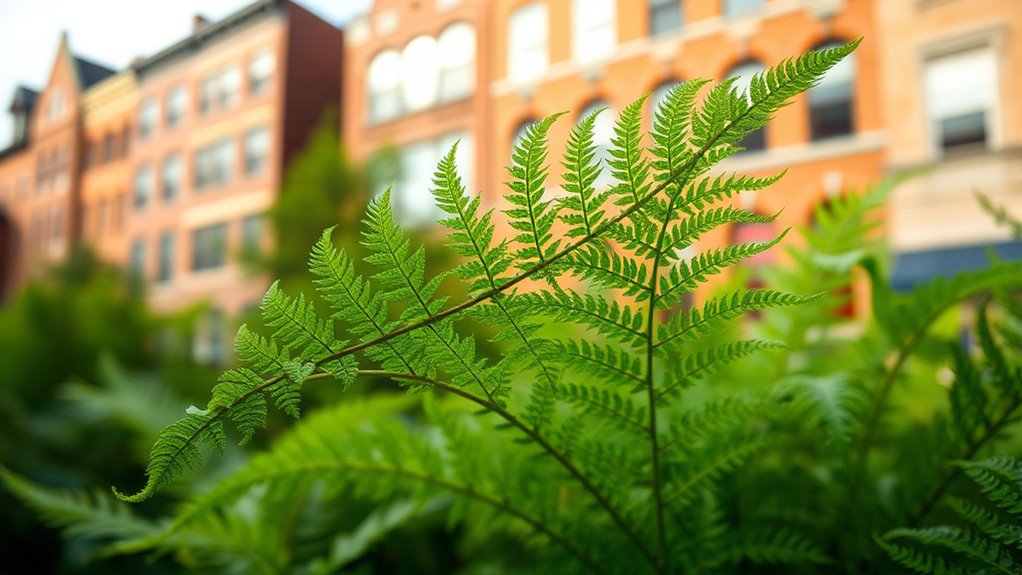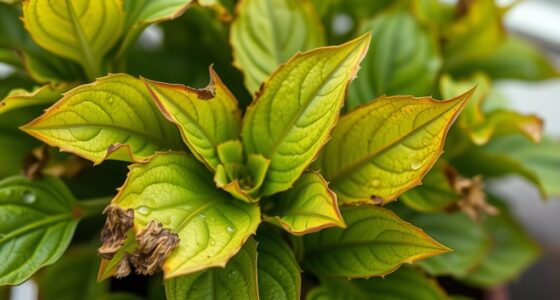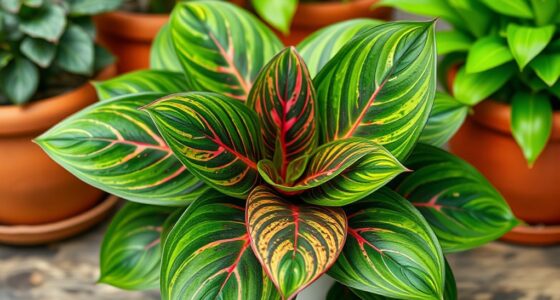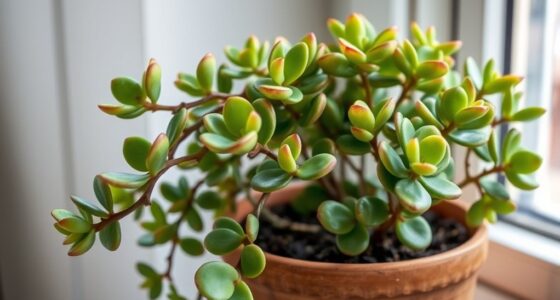Whether you’re caring for a lush Boston fern or a delicate maidenhair, understanding their basic needs is key. Boston ferns thrive in high humidity and consistent moisture, while maidenhair ferns prefer delicate, well-draining soil and gentle water. Both love indirect light and proper airflow. If you’re enthusiastic to master their propagation, pest control, and care routines, discovering these essentials will help you keep your ferns healthy and beautiful over time.
Key Takeaways
- Ferns propagate through spores on their undersides, requiring a moist, sterile medium for successful germination.
- Proper humidity, indirect light, and consistent moisture are essential for healthy fern growth from Boston to Maidenhair.
- Common pests like scale, mealybugs, and spider mites can affect ferns; early detection and treatment are crucial.
- Maintaining good air circulation and avoiding overwatering help prevent pests and promote overall fern health.
- Patience and proper care transform spores into lush, mature ferns across various species and environments.

Have you ever wondered what makes ferns such resilient and fascinating plants? Their ability to thrive in a variety of environments, from the shaded woodlands of Boston to the delicate Maidenhair fern in your living room, is truly remarkable. Understanding fern fundamentals begins with learning how to propagate them effectively. Fern propagation can seem tricky at first, but once you grasp the basics, you’ll find it’s a rewarding process. Most ferns propagate through spores, tiny reproductive structures found on the undersides of their fronds. To start, you need to collect mature spores, which are released when the sporangia (spore cases) turn brown and dry. Next, you’ll spread these spores on a moist, sterile medium like peat moss or a seed-starting mix. Covering the container with plastic helps maintain humidity, mimicking the fern’s natural environment. Place it in indirect light, and within a few weeks, tiny fern gametophytes will emerge. These will eventually develop into young fern plants, which can be transplanted once they’re large enough to handle. Patience is key, but with consistent moisture and proper conditions, you’ll see your ferns multiply and flourish. Additionally, understanding fern propagation techniques can significantly increase your success rate and ensure healthy growth. While growing ferns is satisfying, it’s equally important to understand fern pest management to keep your plants healthy. Ferns, like any other plants, are susceptible to pests such as scale insects, mealybugs, and spider mites. These pests can weaken your ferns by sucking sap and spreading disease, so early detection is crucial. Regularly inspecting your ferns’ fronds and undersides for small, discolored spots or webbing can help you catch problems early. If you notice pests, act quickly by wiping affected areas with a damp cloth or using a gentle insecticidal soap. Avoid harsh chemicals that could harm the fern or your indoor environment. Maintaining proper humidity, avoiding overwatering, and ensuring good air circulation are also critical components of fern pest management. Healthy, well-maintained ferns are less likely to attract pests, creating a cycle of resilience and beauty.
In essence, caring for ferns involves understanding their growth needs and taking proactive steps to propagate and protect them. Whether you’re nurturing a Maidenhair fern or propagating Boston ferns for your collection, mastering fern propagation and pest management will give you the confidence to keep these lush plants thriving. With patience and attention, you’ll transform your space into a lush green oasis, showcasing the natural elegance of ferns. Their resilience is rooted in these fundamental practices, making your journey with ferns both rewarding and inspiring.
Frequently Asked Questions
Which Fern Species Are Best for Low-Light Indoor Environments?
If you’re looking for ferns that thrive in low-light indoor environments, you should consider shade-tolerant varieties. These ferns require minimal fern leaf care and can flourish without direct sunlight. Popular options include the Boston fern and maidenhair fern, both known for their resilience in shaded spots. By choosing these types, you’ll enjoy lush greenery while keeping your fern healthy and vibrant with simple care routines.
How Often Should I Water Different Types of Ferns?
You might think your fern’s hydration needs are simple, but they’re a delicate dance! Watering frequency varies widely among fern types—some crave daily moisture, others prefer weekly drinks. You must observe your fern closely, feeling its soil and adapting accordingly. Overwatering can drown roots, while underwatering leaves it parched. Keep a careful eye on your fern’s signals to ensure it stays lush, vibrant, and happy.
What Are Common Pests That Affect Ferns?
You might notice pests like scale insects, spider mites, or mealybugs on your ferns. Proper pest identification helps you choose the right treatment. Use organic pest control methods, such as neem oil or insecticidal soap, to safely eliminate these pests without harming your plants. Regular inspection guarantees early detection, keeping your ferns healthy and lush. Stay vigilant and act promptly to maintain pest-free, thriving ferns.
How Can I Propagate Ferns at Home?
Did you know that over 80% of fern enthusiasts successfully propagate their plants at home? To do this, start by dividing healthy rhizomes or spores, ensuring you use sterile tools. Regular fern pruning encourages growth, while proper fern fertilization provides essential nutrients. Keep the soil moist and place your ferns in indirect light. With patience, you’ll see new fronds develop, making propagation both rewarding and fun.
What Soil Mix Is Ideal for Healthy Fern Growth?
For healthy fern growth, you need a well-draining soil mix with the right soil pH balance. Use compost ingredients like peat moss, pine bark, and perlite to create a lightweight, moisture-retaining mix. This combination provides nutrients and maintains proper acidity, which ferns prefer. Make sure the soil isn’t too acidic or alkaline, as this can hinder growth. Regularly check and adjust the soil pH to keep your ferns thriving.
Conclusion
Now that you understand fern fundamentals, your garden will transform into a lush, emerald paradise so vibrant, it could make the rainforest jealous. With your newfound knowledge, you’ll nurture your ferns to grow taller than skyscrapers and greener than emeralds, creating a jungle so breathtaking, it’ll leave everyone breathless. Get ready to turn your space into a verdant wonderland where ferns reign supreme—your garden’s about to become the envy of the botanical world!









